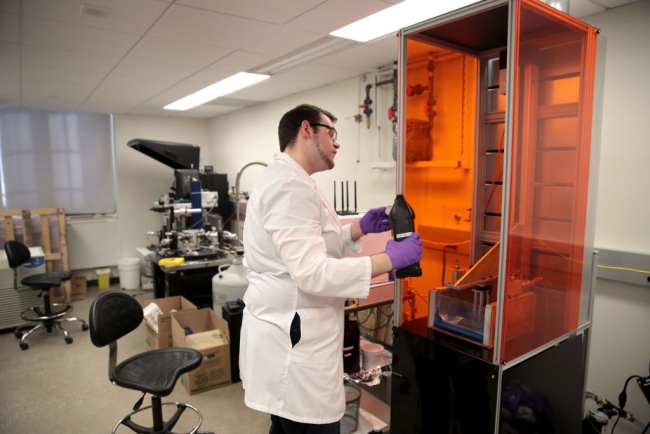You have /5 articles left.
Sign up for a free account or log in.

A new report looks at the changing role senior research officers fill at different universities.
Scott Olson/Staff via Getty Images
College and university research enterprises are growing in size and complexity -- and so is the list of responsibilities for senior research officers, the top-level administrators heading up the research arm at many institutions.
A report released today by Ithaka S+R, a higher education research and advising group, synthesizes interviews with more than 40 senior research officers at major research institutions across the country including Dartmouth College; the University of Iowa; the University of California, Berkeley; Northwestern University; and Florida State University. The report aims to provide more information about the roles of senior research officers at the country’s largest research universities and to understand how college and university research enterprises have changed over time.
"This is a big job," said Roger Schonfeld, the director of the libraries, scholarly communication and museums program at Ithaka S+R and co-author of the report. “But what I don’t think we fully understood was just how big this role has become.”
Senior research officers -- often given the title vice president for research or vice provost for research -- hold universitywide responsibilities. Those responsibilities include overseeing grant proposals, providing leadership and support for research infrastructure like facilities and equipment, overseeing compliance operations and developing partnerships with government agencies and corporations.
The officer role typically fits one of two models. First is the professional model, in which officers take on primarily administrative roles and rarely conduct research themselves. Second is the service model, in which faculty members take on the senior research officer role but continue to lead their own research, planning to one day return to the faculty ranks.
Officers who fall into the service model emphasized the importance of faculty perspective in the role, the report said.
“I did not begin my science career with an intention of being a VPR one day,” one senior research officer said, according to the report. “You asked me why am I doing this? To provide a faculty voice to the administration.”
Nearly all of the senior research officers interviewed for the report have a science background. Most are accomplished researchers in their own right, the report said. Schonfeld and his co-author Oya Rieger, who is senior strategist at Ithaka S+R, wrote that there is a remarkable lack of diversity among senior research officers. Only a quarter are women, according to an analysis of senior research officers at Association of American Universities and Association of Public and Land-grant Universities member institutions.
“If you look at change over the last 10 to 15 years, this role has grown to have more responsibilities, more offices reporting to it, more compliance operations, more administrative functions, but also a tremendous amount of academic functions at a lot of institutions,” Schonfeld said.
As college research offices grow, senior research officers are working to streamline administrative functions and subordinate offices. For example, an institution with a main campus and a health sciences campus may choose to combine the research offices at both. Or an institution may choose to merge the office of human subject safety, the office of animal subject safety and the environmental safety office into a single unit, Schonfeld said.
Streamlining efforts will minimize the administrative burdens on faculty, many senior research officers said.
“Numerous interviewees mentioned the need to improve processes and systems for seeking research funding. They spoke about this work vividly, for example their efforts at ‘knocking down barriers’ and ‘streamlining the bureaucracy,’” the report said. “It was clear that, given the nature of the senior research officer role, this is one of the most significant tools they possess to meet a goal of increasing grant applications and ultimately grant-funded research.”
Some interviewees emphasized the need for more efficient systems across a university, and in some cases across several universities. Linked and automated systems could cut down on the time faculty members spend on data entry, they said.
Almost all of those interviewed mentioned research funding as a strategic priority, according to the report. Most institutions draw funding from the National Institutes of Health and the National Science Foundation. Others mentioned the Department of Defense, the Defense Advanced Research Projects Agency, the Department of Energy and the Department of Education.
In addition, senior research officers are increasingly looking for corporate partnerships to diversify their revenue streams, Schonfeld said.
“That’s a pretty standard risk management approach,” he said. “Someone with revenue responsibilities will want to make sure they’re not overreliant on any single channel.”
Research funding is one of the most stable parts of university budgets, Schonfeld added. The current pressure on net tuition revenues, state appropriations and endowments has for the most part left research funding unscathed.
That said, research budgets are impacted by across-the-board cost cutting at universities that are struggling financially, he said.
Senior research officers are also focused on compliance issues, according to the report. Policy makers and federal science agencies are concerned about undue foreign influence, specifically from China, on federally funded research. Compliance issues resulting from these concerns are still developing, and interviewees reported spending a lot of time in recent years working through these issues, the report said.
The interviewers didn’t ask research officers specifically about the COVID-19 pandemic’s impact on research administration at their institution. That was covered separately in an earlier report, released in October.








